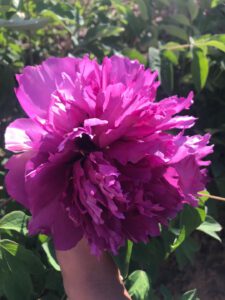Tree Peony is a traditional flower of our country. It elegant, National Color Tianxiang, known as the “King of flowers” , is the Chinese people in the mind of the “national flower.
tree Peony for deciduous small shrubs, like cool fear of heat, like wet, like light, slightly shade-resistant. The flowering period of tree peony is usually mid-to-late April in Central Plain area, and later in cold area, sometimes to June. After anthesis, the growth and development of Paeonia SUFFRUTICOSA has entered another very important stage. The Flower Bud differentiation of Paeonia Suffruticosa, from the middle and late May to the middle of June, from the south to the north, began one after another, and generally lasted until November in 10.

Summer is the key period of nutrition accumulation and flower bud differentiation of tree Peony Growth and development, and is also the period of disease, insect, weed, drought and flood. Therefore, strengthening the scientific management of tree Peony in summer is beneficial to the healthy growth and good development of peony.
The main objective of tree peony management in summer is to protect leaves and root, to promote growth and to promote flower bud differentiation. The main technologies are as follows:
Diseases and insect pests control summer high temperature and high humidity, diseases and insect damage is more serious, mainly leaf diseases and eating pests. In order to prevent and control diseases and insect pests, the principle of combining prevention with control should be adhered to, so as to ensure a longer period of photosynthesis and improve the physiological activity of root system. The specific measures are:

Spraying foliar protectant
About 2 weeks after flowering, the leaves were sprayed with 0.5% lime bordeaux mixture to prevent the infection of the pathogen. The general effect can last about two weeks, continuous spray 2 times. The dosage is about 100 kg per mu.

Fungicide spray
In August, the fungicides such as tobrazine, Carbendazim, chlorothalonil and Triadimefon were applied 4 times, and generally once every 10 days.

Pest control
Can Combine to spray fungicide, in the liquid insecticide such as pyrethroid insecticide, Omethoate, etc. , to control eating pests.
Drainage is one of the important measures of the Peony Tube, and in some areas, drought often occurs, so irrigation should be done in time. Specific measures for drainage are as follows:

Make preparations for waterlogging prevention conscientiously
Before entering the rainy season, it is necessary to repair the drainage ditch in the field. Low-lying areas, the Peony Garden (Pu) around the flood cofferdam to prevent heavy rain when the inflow of external ground. Large planting areas should be provided with drainage pumps for emergency use.
Timely drainage
If the storm water, immediately after the organization of force, rapid drainage. It can also accelerate the water loss of plough layer by deep tillage or increasing the times of tillage.
It can eliminate the underground lamination and effectively eliminate the soil gravity water
Some tree peony ornamental garden as a result of mechanical extrusion in the process of capital construction, forming a solid layer of underground slab. Plowing layer water can make peony rotten roots, often lead to peony “autumn hair” , the heavy ones lead to large areas of peony withered. The utility model can dig deeper drainage ditches in the fields or drill holes between the rows to facilitate drainage. Poor drainage is one of the important reasons for peony “degeneration” in rainy areas.

Scientific fertilization and adequate supply of fertilizer and water are the basis of good growth and development of peony in summer. For the gardens lacking fertilizer, multi-element compound fertilizer (2:2:1 or 2:1:1) should be applied to the NPK rating, 15 ~ 20 kg per mu, and water should be poured in time after hole application. Conditional can be applied at the same time outside the root topdressing, such as spraying 0.20.5% Monopotassium phosphate, foliar, spraying treasure or other trace fertilizer.

Summer is the peak season for weeds. Weeds not only compete with peony for water and fertilizer, but also make the field overfull, reduce the ability of ventilation and light transmission, cause disease and insect damage, weaken photosynthesis, and affect flower bud differentiation. Intertillage can not only weed, but also keep moisture. The average summer time is 5 — 6. In some places, the method of spreading hay between plant rows is used to restrain the growth of weeds and also to keep moisture and cool down the temperature.
